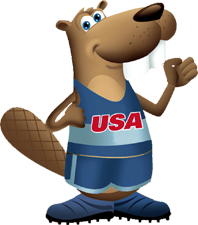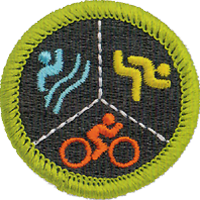Multisport


Resources
- Multisport Merit Badge Pamphlet
- Scoutmaster Bucky's Merit Badge Advancement Quick Reference
- Scoutmaster Bucky's Acknowledgement Form
Multisport Requirements
Current Scouts BSA requirements
as of December 6, 2025
as of December 6, 2025
1.
Do the following:
a.
Explain to your counselor the most likely hazards you may encounter
during multisport activities and what you should do to anticipate,
prevent, mitigate, and respond to these hazards.
b.
Show that you know first aid for injuries or illnesses that could occur
while participating in multisport events, including abrasions,
blisters, concussions, contusions, dehydration, hypothermia,
overheating, sprains, and strains.
2.
Do the following:
a.
Explain the importance of a physical exam and have your health care
practitioner give you a physical examination using the Scouting America
Annual Health and Medical Record.
b.
Explain the importance of maintaining good health habits, especially
during training, and how the use of tobacco products, alcohol, and
other harmful substances can negatively affect your health and your
performance in athletic activities.
c.
Define a healthy diet and explain the importance of maintaining a
healthy diet.
3.
Do the following:
a.
Discuss with your counselor your level of familiarity and experience
with the multisport events (swimming, biking, and running) and the
order and distance of each sports segment.
b.
Explain to your counselor which multisport event (swimming, biking, or
running) you feel is your strongest and which you could improve upon
the most.
c.
Identify the required equipment for each of the three common multisport
events (swimming, biking, and running).
d.
Based on your interests, experience, and discussion with your
counselor, select ONE of the following multisport formats to
concentrate on for the remaining requirements:
1.
Triathlon: swimming, biking, and running
2.
Duathlon: running and biking
3.
Aquathlon: swimming and running
4.
Aquabike: swimming and biking
4.
Complete ALL of the activities that apply to the multisport format you
selected in requirement 3(d) (Triathlon, Duathlon, Aquathlon, or Aquabike):
a.
Swimming
1.
Before doing requirements 5 through 8, earn the Swimming merit
badge.
2.
Explain the components of the Scouting America Safe Swim Defense
program and how you will ensure they are in place when you swim.
3.
Explain to your counselor the difference between a pool swim and an
open water swim, including at what water temperature it is
appropriate to wear a wet suit.
b.
Biking
1.
Explain to your counselor how to ride predictably, be conspicuous,
think ahead, and ride ready.
2.
Discuss what should be checked regularly to make sure the bicycle
is safe to ride.
3.
Explain the importance of wearing a properly sized and fitted
helmet while cycling and of wearing the right clothing for the
weather.
c.
Running
1.
Demonstrate a proper run warmup and cool-down. Explain to your
counselor the importance of maintaining healthy habits, including
hydration, nutrition, injury prevention, and rest.
2.
Learn and state the basic rules of the road for runners.
3.
Demonstrate important running drills, including high knees, butt
kicks, lunges, inchworms, and soldier kicks.
5.
Do the following:
a.
With guidance from your counselor, establish a four-week training plan
that combines your chosen multisport format to develop proper
techniques, gain self-confidence, and increase endurance. Each session
should last at least 25 minutes and include a proper warmup before the
session and stretching afterward.
b.
Use a chart or other tracking method to monitor your training and
development during this period.
c.
Set a personal goal for improvement based on one or more of the
following criteria: time, technique, or distance.
d.
At the end of four weeks, discuss your progress with your counselor and
tell how your development has affected you mentally and physically.
6.
Learn the methods of setting up your transition area, which is where your
bike equipment and/or running gear will be. Discuss with your counselor how
to smoothly and safely transition from one element to the next, such as
mounting and dismounting your bike or adjusting your gear.
7.
After completing requirements 1-6, complete all of the activities (on the
same day and consecutively) for the multisport focus area that you selected
in requirement 3(d), including demonstrating a smooth and safe transition
between each:
a.
Triathlon: swim (100 m), bike (3 km), and run (1 km)
b.
Duathlon: run (1.5 km), bike (3 km), and run (.75 km)
c.
Aquathlon: swim (100 m) and run (1 km)
d.
Aquabike: swim (100 m) and bike (3 km)
Note: When referring to race distances, "m" stands for meter
(about 3.28 feet) and "km" or simply "k" stands for kilometer (about
0.62 mile).
8.
Do TWO of the following and discuss with your counselor:
a.
Research and identify two ways you can continue participating in
multisport after completing this merit badge.
b.
Research an Olympic, Paralympic, or professional triathlete (past or
current). Share information on their background in the sport and what
inspires you most about this individual.
c.
Demonstrate leadership by starting a training group and educating your
peers on the importance of physical activity, nutrition, and the
disciplines of multisport.
d.
Sign up for and participate in a sanctioned multisport event in your
area.
e.
Volunteer at a local multisport event, running race, biking event, swim
meet, or adaptive sporting event.